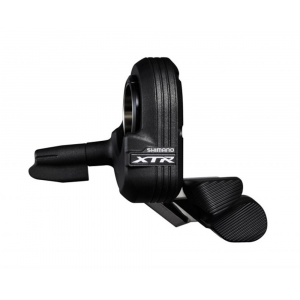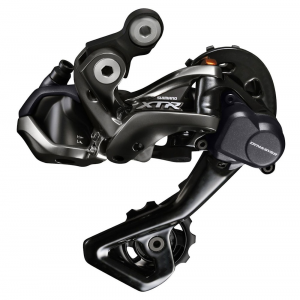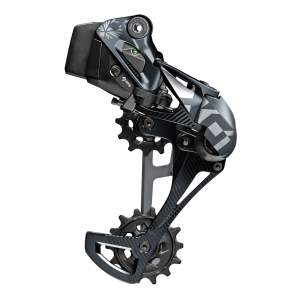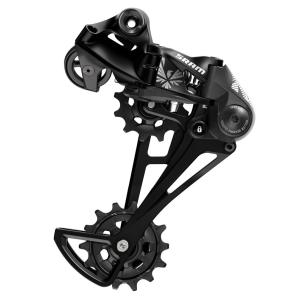Shimano XTR Di2 M9050
(discontinued)
| Where To Buy | |||
|---|---|---|---|
Free shipping on orders over $50 (continental U.S. only).
International shipping available. Some exclusions apply. |
Free shipping on orders over $50 (continental U.S. only).
International shipping available. Some exclusions apply. $254.99
|
||
Free shipping on orders over $50 (continental U.S. only).
International shipping available. Some exclusions apply. |
Free shipping on orders over $50 (continental U.S. only).
International shipping available. Some exclusions apply. $719.99
|
||
Review by Brandon Turman // Photos by Courtney Steen and Brandon Turman

Maybe it was our hangover from the launch party the night before, but we were overwhelmed the first time we laid eyes on our Santa Cruz Bronson test bike equipped with Shimano's electronic XTR Di2 drivetrain. "What the hell are all these tiny little wires all over the bike? Why are the shift levers backwards? And for god's sake, STOP BEEPING."
Yeah, it probably was the hangover.
Like many, we couldn't stand the thought of electronics on a bike. Part of why we go mountain biking is to get away from all of that. Yet here we were, tasked with testing this intruder.
If we're honest, part of us wanted it to fail. It'd be far easier to hate all over it than to attempt to convince fellow naysayers that there may in fact be some good in this modern devil. But we've been beating on it for over a year to no avail. Did our preconceived notions get the better of us? Is there some simplicity in all this complication? Can a front derailleur really be a good thing?
XTR Di2 M9050 Highlights
- World's first mountain bike specific, commercially available wired electronic drivetrain
- Integrates with mechanical XTR M9000 Race or Trail 1x11, 2x11, or 3x11 components with 11-40 and 11-42 tooth cassettes
- Two derailleurs with one shifter possible with Synchronized Shift technology
- Customizable shift patterns
- Programmable single or multi-shift modes, shift speed, and actions for each shifter and button
- Ability to integrate with FOX iCD/iRD suspension adjusters
- Auto trim front derailleur
- Low profile Shadow RD+ rear derailleur with GS and SGS cage options
- Typical battery capacity of 300 to 400-miles of riding
- Upgradeable and expandable
- MSRP $2,240 US as tested

Installation
If installing and setting up XTR Di2 seems like a daunting task, know that you're not alone. On top of the myriad of odd part numbers and compatibility charts to navigate, we're dealing with an entirely new system here, complete with a battery, display unit, and wires you've likely never worked with before.
While the first time will no doubt be a learning experience, once the components are in place and the wires are plugged in, tuning is actually quite simple. Set the limit screws, press a few buttons, and the system practically takes care of itself, yielding a precise shift and bang on accuracy that's nearly impossible to replicate with a mechanical drivetrain from both tuning and operational perspectives. The digital plus/minus adjustment mode has the same effect as tensioning or loosening a cable with a barrel adjuster.

Though the number seems to be growing at a slow rate, very few mountain bike frames are made with Di2 in mind. Those that are Di2 compatible look as clean as can be with nifty ports for the cables and battery, while the majority will need to employ a mixture of electrical tape, zip ties, and heat shrink tubing to tame the network of wires running to and fro. Shimano's line of PRO Tharsis handlebars and stems offer a good solution for tidying up the cockpit area, allowing wires to travel inside the bars and through the steerer tube. Tharsis stems include an internal steerer tube mount for the battery that can also help clean things up, or you can opt to use your frame's bottle mounts as the default option.

Synchro Shift and E-Tube Project Customization
One of the features that makes XTR Di2 stand out is Shimano's Synchronized Shift technology, which allows you to have a 2X drivetrain with just one shifter. This frees up space for a dropper post lever under the left side of your handlebar. Of course there's always the option to put the system in manual mode and shift as you normally would, front shifter on the left and rear shifter on the right.
While you may be thinking that "shifting isn't rocket science and I can do it just fine myself, thank you very much," handing control over to Synchro Shift is the key to the best Di2 experience and the biggest reason why Di2 appeals to some riders. As shown in this video, Synchro Shift is programmed to keep the ideal pair of gears rolling at all times, automatically shifting between the front and rear chainrings as needed to achieve the next hardest or easiest gear ratio:
With a 2X setup, Synchro Shift effectively provides more gear ratios than competing 1X designs, creating smaller jumps and a more even progression across a wide range. For a rider that prefers a smooth cadence, that's the crux to the whole thing. You can nerd out on gear ratios and efficiencies in this video if you're inclined.
You're able to configure two shift patterns using Shimano's E-Tube Project software, which can then be selected on the bike by double tapping a small button on the display unit. Interestingly, Shimano's default shift patterns make use of the big-big gear combo, which has long been held as a no-no due to the potential for accelerated wear as a result of cross-chaining.

After a brief period with the default shift patterns shown above, we opted to create a slightly modified pattern designed to rely on the big front ring for all but the last big cog in the back. This pattern allows us to avoid front shifts while powering down a hill, and can be handy in an enduro race scenario. We also customized a more climb-friendly map that allows the use of most of the cassette while in the little front ring for extended climbs, as the Santa Cruz Bronson climbs better in the small chainring.
The E-Tube software also allows you to adjust several other settings, including what each shifter trigger button does, the speed of shifts, and the beeping alert noises the drivetrain makes before shifting front chainrings. Right off the bat we opted to switch the default up/downshift function of the trigger buttons for a more natural shifting experience.
On The Trail
Performance on trail has been nothing short of impressive, though it took a little time to get used to the system and find the customizable settings that worked best for our needs.
Pressing the shift lever is a wild experience as the drivetrain comes to life, emitting robotic buzzing noises, beeps, and showing an excess of information on the display unit. The shift levers are easy to actuate with a short throw and audible "click" sound. Push once to shift once, push hard to shift twice, or push and hold in either position to shift multiple times until you release the lever.
The derailleur motors instantly engage when the shifter is pressed, moving a precise amount from gear to gear every time. The consistency and speed with which the derailleurs move is what makes Di2 a big draw for those that have experienced it. With a mechanical system we instinctively attempt to press the lever the right amount, tensioning the cable just enough to shift. Most times we nail it, although over- or under-shifting is still a common occurrence, especially while riding at the limit.

With just one shifter (which removes the ability to quickly change between front chainrings) and smaller, more numerous gear jumps than a 1X system, we found ourselves in need of quicker shifts while riding unfamiliar and hilly terrain. On a mechanical system it's possible to dump several gears when you encounter an unexpected climb by pressing the shift lever all the way in a few times, but with Di2 you're limited to the preset speed of the system. We were able to increase the shifting speed using the E-Tube software, significantly reducing the time it takes to go from one end of the shift pattern to the other. Going back and forth between bikes, we found that we prefer the singular motion of holding a button down versus rotating our wrist several times. Provided you have a reasonably quick cadence, holding the lever down for multiple shifts results in what feels like perfectly smooth progression up or down, step by step, regardless of your power input to the cranks.
While aggressive trail riders and enduro racers may value it less than cross-country athletes, those tight gear jumps are appreciated on smoother terrain where a consistent cadence can be a valuable tool in regulating your body's energy output. We also enjoyed being able to shift up or down just slightly on steep, loose climbs without bogging down, spinning out, or losing much momentum.
Drivetrain noise is minimal thanks to the Auto Trim feature on the front derailleur, which self-adjusts by small amounts to prevent the chain from rubbing as you shift across the cassette. A small rubber pad on the bottom of the front derailleur's cage also helps in this regard. We experienced little to no perceptible grinding in any of the gear combos. Backpedaling in the largest rear cog is hit or miss - sometimes it works well, other times it hops down a gear or three.

The derailleur's clutch mechanism does an honorable job at keeping the chain on the chainrings and away from the chainstay, although we dropped chains ~8-10 times over the course of the year. Shimano says they've optimized the chainring tooth shape and the way the rear derailleur follows the contour of the cassette to create "the most amount of chain retention you could ever hope for without the use of a guide."
Performance of the sealed system was unaffected by stream crossings, rain, or running through the gears while cleaning with a hose.

What about battery life? Well, it's unlikely to leave you stranded in the middle of nowhere. Yes, you will need to charge it every few months depending on how often you ride, but the battery lasts so long that we actually forgot where the charger was the first time it was drained. One has to wonder if the battery could be made smaller given how long it lasts.
What happens when it dies? First, the front derailleur stops functioning with little warning other than the battery indicator being at the 1/4-full mark. This locks you into one of the two front chainrings. You're then limited to the gears you programed to be active in that chainring unless you switch to the manual shift mode. From this point you have about 20 full shifts across the cassette before it really starts to struggle. It then starts acting a lot like a dead flash light - give it a minute and you might be able to get a little more juice out of it, yielding 3 or 4 more rear shifts. From then on you're pretty much single-speedin'. Given how drawn out the process is, we feel Shimano worked in plenty of warning and reserve power to finish out just about any single-day ride.
Long Term Durability
We often begin to see durability issues with drivetrain components after just two to three months of solid use, but Shimano's XTR Di2 system threw us for a loop when it kept on ticking well past this mark. Our test bike has been ridden long enough to completely wear out two sets of tires, and was ridden in various locations world wide in all types of weather.

In just over a year of use, it's remarkable to look back at how few times we've had to perform maintenance. In addition to a few quick button presses on the display unit's adjustment mode, we've had to adjust the rear derailleur limit screws, b-tension, and clutch strength one time. That's it. No barrels to twist, cables to lube, housing to replace, or frayed cable ends to deal with. Battery life over the year has been pretty consistent as well, though we've noticed it takes longer to recharge each time the battery is fully depleted.
We've experienced no chain breaks, those "tiny little wires" are all intact, and the cassette and chainrings show very little wear once cleaned. At this point the crank's finish is the biggest wear issue, and it's purely cosmetic.
Our cassette has had a consistent creak in the easiest two or three gears on steep climbs, however. The temporary fix involves removing the cassette, cleaning it, and greasing the carriers. This solution works but doesn't last long.

Given the $573 (!) replacement cost, we cringe every time the rear derailleur tags a rock. Durability has been surprisingly good though, and despite a handful of solid impacts it continues to function very well. Should you hit the derailleur hard enough, the motor will disengage as a safeguard against further damage. It's then necessary to ensure the hanger is straight before holding the button on the display unit for three seconds to reset the system.
Like all XTR components, Shimano backs XTR Di2 with a three year warranty.
Things That Could Be Improved
While a very positive riding experience and great durability ultimately made us rethink our position on electronic shifting, Shimano's XTR Di2 isn't without fault:
Mac Compatibility - For starters, the E-Tube Project software used to configure the system isn't compatible with Mac computers and won't be in the foreseeable future. Hold on four minutes while we boot up the old dinosaur PC from the depths of the basement... While it's possible to run it as a PC application on a Mac using Parallels, we haven't had the need to do so with any other application for several years. The software is also clunky at best. Luckily Shimano is working to address this oversight. New iPad, iPhone, and Android applications are set to launch in July, September, and November, respectively, though you'll need to own the most recent display unit and battery which feature Bluetooth connectivity.

Huge Envelope for Front Derailleur - We've seen several frames move to 1X only in the past two years, and we think this trend will continue to grow. With demands for shorter chainstays, better tire clearance, stiffer rear ends, and suspension designs all jostling for real estate, there's only so much space in the bottom bracket area - that's partly why we got the new 148mm Boost axle standard if you recall. Shimano's XTR Di2 front derailleur is the largest of all modern options, and presents a real challenge for bike designers.
1X Range - The way we see it, it makes the most sense to use Di2 with a front derailleur (sans front shifter) thanks to its Syncro Shift capabilities and extended range. Not every bike is ideal with 2X, however. While the ratio jumps may be perfect, the effect of changing chainrings on a suspension design's level of antisquat can be very noticeable on some bikes - this is why we suggest separate climbing and descending shift patterns. For those that prefer to go the 1X route, know that XTR Di2 is "officially" limited to a maximum 11-42 tooth cassette, which has a much smaller overall range than SRAM alternatives.

Muddy Conditions - Despite great fair weather performance regardless of the gearing combination or load, we experienced ghost shifts (skipping) while climbing steep grades in the mud while using the easiest two or three gears out back. A consultation with Shimano's tech reps revealed that they hadn't experienced similar issues, and a slight misalignment at the hanger, b-link, or rear derailleur itself may have been worsened by mucky gears. Shimano also says they've improved ghost shifting with a new offset pulley and forward jockey wheel position, and the weight of the derailleur's motor unit adds stability to the complete assembly.
Shifter Ergonomics and Strength - The lever position can be customized along the bar's axis, but unlike most shifters there is little differentiation between the two triggers. The plastic shifter also seems to be the flimsiest component in the system, rotates around the bar at Shimano's specified torque spec, and - though it can be fixed with the E-Tube software - the default setting for the upshift and downshift will seem as though they are backwards for most users.

Very High Price - There's no debating this one. XTR Di2 is flat out expensive. Like really, really expensive, even after a slight price decrease since it was first launched. You're looking at upwards of $2,240 US for the 2X Syncro Shift setup we used in this test. Luckily XT Di2 will soon be available for those who want the tech for less, though it's still very pricey compared to mechanical alternatives.

What's The Bottom Line?
So, does electronic shifting have a place on mountain bikes? We went into this test doubting just how applicable it was, but the performance, durability, and reliability of Shimano's XTR Di2 drivetrain ultimately won us over. While it may seem very complex and can be a hassle to install, it's incredibly simple to use on trail and yields a perfect shift every time. Because gear range is limited in the 1X realm, we feel it's best for the rider that values the carefully calculated and consistent gear ratio jumps that are only possible with a 2x11 setup. The only real point of contention is the astronomically high price, though the trickle-down is already happening and our drivetrain has required next to no maintenance in over a year of hard use.
Visit www.shimano.com or www.ridextr.com for more details.
Bonus Gallery: 35 photos of Shimano XTR Di2 up close and in action
About The Reviewer
Brandon Turman - Age: 30 // Years Riding MTB: 15 // Height: 5'10" (1.78m) // Weight: 175-pounds (79.4kg)
"I like to have fun, pop off the bonus lines on the sides of the trail, get aggressive when I feel in tune with a bike, and really mash on the pedals and open it up when pointed downhill." Formerly a Mechanical Engineer and Pro downhill racer, Brandon brings a unique perspective to the testing game as Vital MTB's resident product guy. He has on-trail familiarity with nearly every new innovation in our sport from the past 5-6 years and a really good feel for what’s what.
Specifications
SGS or GS pulley cage
Accurate chain position in every gear
Consistent shifting in every gear combination
New Shimano Synchronized Shift
System communication with front derailleur
SHADOW RD+ chain stabilizer with easy adjust
CFRP plate
For 1x11: 46 tooth - 11 tooth
For 2x11: 42 tooth - 11 tooth
For 3x11: 40 tooth - 11 tooth
| Where To Buy | |||
|---|---|---|---|
Free shipping on orders over $50 (continental U.S. only).
International shipping available. Some exclusions apply. |
Free shipping on orders over $50 (continental U.S. only).
International shipping available. Some exclusions apply. $254.99
|
||
Free shipping on orders over $50 (continental U.S. only).
International shipping available. Some exclusions apply. |
Free shipping on orders over $50 (continental U.S. only).
International shipping available. Some exclusions apply. $719.99
|
||



























9 comments
Post a reply to: Long Term Tested: Shimano's Electronic XTR Di2 Drivetrain